Jamal Toutouh
Fast energy-aware OLSR routing in VANETs by means of a parallel evolutionary algorithm
Jan 17, 2025Abstract:This work tackles the problem of reducing the power consumption of the OLSR routing protocol in vehicular networks. Nowadays, energy-aware and green communication protocols are important research topics, specially when deploying wireless mobile networks. This article introduces a fast automatic methodology to search for energy-efficient OLSR configurations by using a parallel evolutionary algorithm. The experimental analysis demonstrates that significant improvements over the standard configuration can be attained in terms of power consumption, with no noteworthy loss in the QoS.
A swarm algorithm for collaborative traffic in vehicular networks
Jan 17, 2025Abstract:Vehicular ad hoc networks (VANETs) allow vehicles to exchange warning messages with each other. These specific kinds of networks help reduce hazardous traffic situations and improve safety, which are two of the main objectives in developing Intelligent Transportation Systems (ITS). For this, the performance of VANETs should guarantee the delivery of messages in a required time. An obstacle to this is that the data traffic generated may cause network congestion. Data congestion control is used to enhance network capabilities, increasing the reliability of the VANET by decreasing packet losses and communication delays. In this study, we propose a swarm intelligence based distributed congestion control strategy to maintain the channel usage level under the threshold of network malfunction, while keeping the quality-of-service of the VANET high. An exhaustive experimentation shows that the proposed strategy improves the throughput of the network, the channel usage, and the stability of the communications in comparison with other competing congestion control strategies.
Infrastructure Deployment in Vehicular Communication Networks Using a Parallel Multiobjective Evolutionary Algorithm
Jan 17, 2025Abstract:This article describes the application of a multiobjective evolutionary algorithm for locating roadside infrastructure for vehicular communication networks over realistic urban areas. A multiobjective formulation of the problem is introduced, considering quality-of-service and cost objectives. The experimental analysis is performed over a real map of M\'alaga, using real traffic information and antennas, and scenarios that model different combinations of traffic patterns and applications (text/audio/video) in the communications. The proposed multiobjective evolutionary algorithm computes accurate trade-off solutions, significantly improving over state-of-the-art algorithms previously applied to the problem.
Intelligent OLSR Routing Protocol Optimization for VANETs
Jan 16, 2025Abstract:Recent advances in wireless technologies have given rise to the emergence of vehicular ad hoc networks (VANETs). In such networks, the limited coverage of WiFi and the high mobility of the nodes generate frequent topology changes and network fragmentations. For these reasons, and taking into account that there is no central manager entity, routing packets through the network is a challenging task. Therefore, offering an efficient routing strategy is crucial to the deployment of VANETs. This paper deals with the optimal parameter setting of the optimized link state routing (OLSR), which is a well-known mobile ad hoc network routing protocol, by defining an optimization problem. This way, a series of representative metaheuristic algorithms (particle swarm optimization, differential evolution, genetic algorithm, and simulated annealing) are studied in this paper to find automatically optimal configurations of this routing protocol. In addition, a set of realistic VANET scenarios (based in the city of M\'alaga) have been defined to accurately evaluate the performance of the network under our automatic OLSR. In the experiments, our tuned OLSR configurations result in better quality of service (QoS) than the standard request for comments (RFC 3626), as well as several human experts, making it amenable for utilization in VANET configurations.
Parallel multi-objective metaheuristics for smart communications in vehicular networks
Jan 16, 2025Abstract:This article analyzes the use of two parallel multi-objective soft computing algorithms to automatically search for high-quality settings of the Ad hoc On Demand Vector routing protocol for vehicular networks. These methods are based on an evolutionary algorithm and on a swarm intelligence approach. The experimental analysis demonstrates that the configurations computed by our optimization algorithms outperform other state-of-the-art optimized ones. In turn, the computational efficiency achieved by all the parallel versions is greater than 87 %. Therefore, the line of work presented in this article represents an efficient framework to improve vehicular communications.
Automatic tuning of communication protocols for vehicular ad hoc networks using metaheuristics
Jan 15, 2025Abstract:The emerging field of vehicular ad hoc networks (VANETs) deals with a set of communicating vehicles which are able to spontaneously interconnect without any pre-existing infrastructure. In such kind of networks, it is crucial to make an optimal configuration of the communication protocols previously to the final network deployment. This way, a human designer can obtain an optimal QoS of the network beforehand. The problem we consider in this work lies in configuring the File Transfer protocol Configuration (FTC) with the aim of optimizing the transmission time, the number of lost packets, and the amount of data transferred in realistic VANET scenarios. We face the FTC with five representative state-of-the-art optimization techniques and compare their performance. These algorithms are: Particle Swarm Optimization (PSO), Differential Evolution (DE), Genetic Algorithm (GA), Evolutionary Strategy (ES), and Simulated Annealing (SA). For our tests, two typical environment instances of VANETs for Urban and Highway scenarios have been defined. The experiments using ns- 2 (a well-known realistic VANET simulator) reveal that PSO outperforms all the compared algorithms for both studied VANET instances.
Evolutionary latent space search for driving human portrait generation
Apr 25, 2022



Abstract:This article presents an evolutionary approach for synthetic human portraits generation based on the latent space exploration of a generative adversarial network. The idea is to produce different human face images very similar to a given target portrait. The approach applies StyleGAN2 for portrait generation and FaceNet for face similarity evaluation. The evolutionary search is based on exploring the real-coded latent space of StyleGAN2. The main results over both synthetic and real images indicate that the proposed approach generates accurate and diverse solutions, which represent realistic human portraits. The proposed research can contribute to improving the security of face recognition systems.
Citizen centric optimal electric vehicle charging stations locations in a full city: case of Malaga
Sep 10, 2021



Abstract:This article presents the problem of locating electric vehicle (EV) charging stations in a city by defining the Electric Vehicle Charging Stations Locations (EV-CSL) problem. The idea is to minimize the distance the citizens have to travel to charge their vehicles. EV-CSL takes into account the maximum number of charging stations to install and the electric power requirements. Two metaheuristics are applied to address the relying optimization problem: a genetic algorithm (GA) and a variable neighborhood search (VNS). The experimental analysis over a realistic scenario of Malaga city, Spain, shows that the metaheuristics are able to find competitive solutions which dramatically improve the actual installation of the stations in Malaga. GA provided statistically the best results.
Reliable and Fast Recurrent Neural Network Architecture Optimization
Jun 29, 2021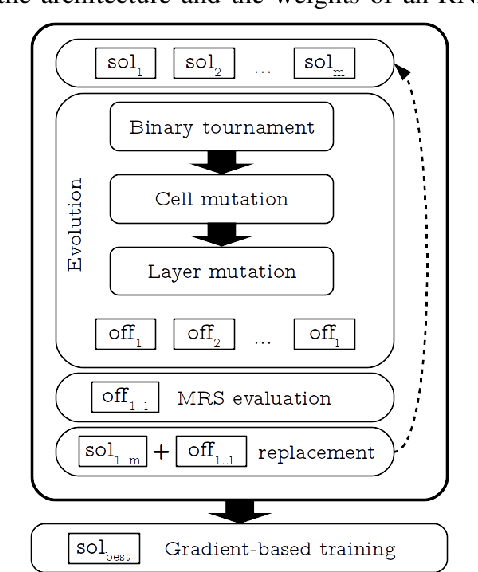
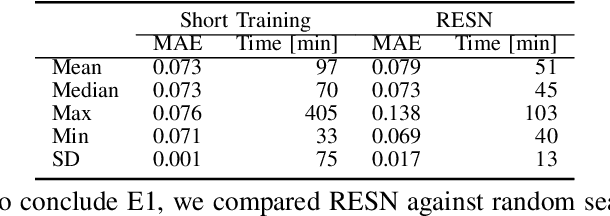
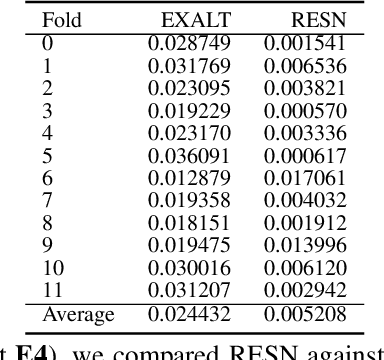

Abstract:This article introduces Random Error Sampling-based Neuroevolution (RESN), a novel automatic method to optimize recurrent neural network architectures. RESN combines an evolutionary algorithm with a training-free evaluation approach. The results show that RESN achieves state-of-the-art error performance while reducing by half the computational time.
Fostering Diversity in Spatial Evolutionary Generative Adversarial Networks
Jun 25, 2021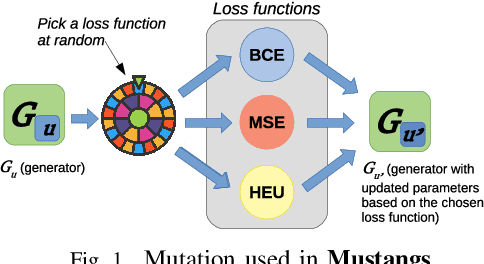
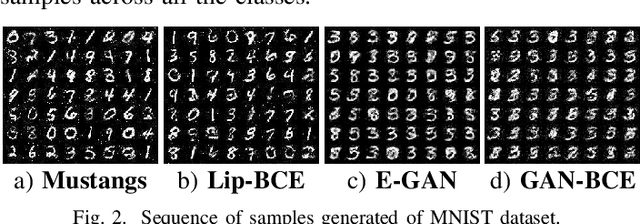
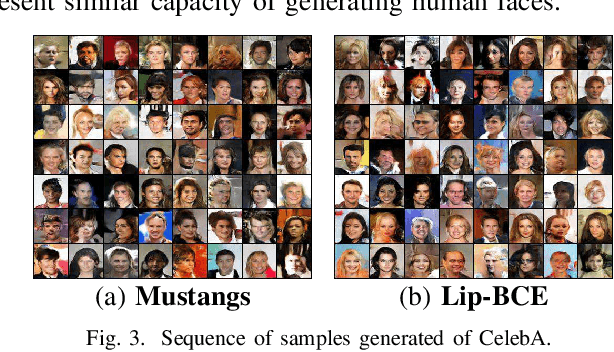
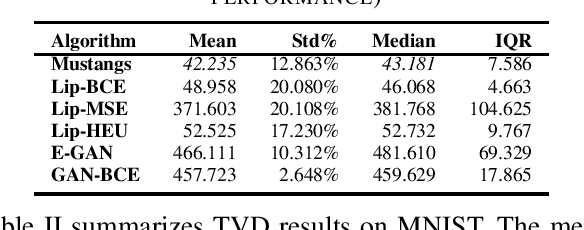
Abstract:Generative adversary networks (GANs) suffer from training pathologies such as instability and mode collapse, which mainly arise from a lack of diversity in their adversarial interactions. Co-evolutionary GAN (CoE-GAN) training algorithms have shown to be resilient to these pathologies. This article introduces Mustangs, a spatially distributed CoE-GAN, which fosters diversity by using different loss functions during the training. Experimental analysis on MNIST and CelebA demonstrated that Mustangs trains statistically more accurate generators.
 Add to Chrome
Add to Chrome Add to Firefox
Add to Firefox Add to Edge
Add to Edge